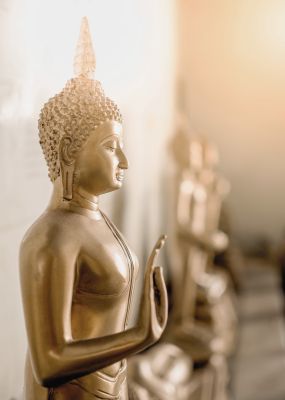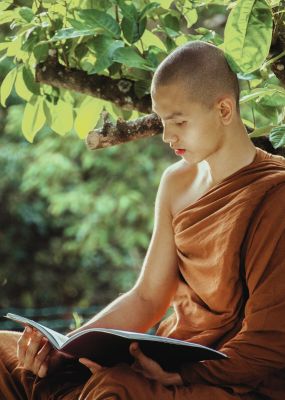Buddhism is a philosophy and way of life that has been around for thousands of years. Its teachings, originating from the wisdom of Siddhartha Gautama, who became known as the Buddha, offer profound insights into the nature of suffering, the path to inner peace, and the realization of enlightenment.
In this blog, I want to share my own experience embracing Buddhist principles, along with some basics on Buddhism, so you can better understand the Buddha’s teachings and how they might enrich your life.
Buddhism is not just a religion; it is a guide to living mindfully and compassionately. At its core, Buddhism teaches the Four Noble Truths and the Eightfold Path, which provide a roadmap for understanding and overcoming suffering humanity faces.
In this blog, I will break down these foundational principles of Buddhism to help you easily navigate and explore its teachings.
I encourage you to bookmark this page and return to it as you progress on your journey. Each time you revisit, you will likely discover new insights and deeper understandings that can enhance your practice and enrich your life.
A Beginner’s Guide to the Principles of Buddhism
- Who Was the Buddha?
- The Bodhi Tree and Buddha’s Enlightenment
- The Four Noble Truths
- The Noble Eightfold Path
- How do I practice the Eightfold Path?
- Mindfulness and Meditation
- The Middle Way
- What is Karma
- What about Past Life Karma?
- What do Buddhists believe about Reincarnation
- What is Nirvana
- Different Traditions in Buddhism
- The Significance of Buddhist Monks
- Personal Growth Through Buddhism
Who was the Buddha?
The Buddha, born Siddhartha Gautama, was a prince and the son of King Suddhodana and Queen Maya. His early life was filled with luxury and isolation from the outside world. A prophecy had foretold that Siddhartha would either become a great king uniting India or a revered spiritual leader achieving enlightenment and guiding countless souls.

To steer him towards kingship and shield him from the world’s suffering, his father kept him confined within the palace walls, surrounded by pleasure and comfort.
Despite his father’s efforts, Siddhartha ventured outside the palace at the age of 29.
During his outings, he encountered four sights that deeply affected him. These sights profoundly shook him, making him realize that his privileged life could not shield him from sickness, aging, and death.
- An Old Man: He saw an old man, which made him realize that aging is a part of life.
- A Sick Person: He saw a sick person, understanding that illness and suffering are unavoidable.
- A Dead Body: He saw a dead body, confronting the reality of death.
- A Holy Man: He saw a holy man who had renounced the world, which inspired him to seek a spiritual path.
Afterward, determined to find answers, Siddhartha left his royal life and family to become a wandering ascetic. He studied with various teachers and practiced extreme forms of self-denial and asceticism. However, he found that these practices did not lead to the enlightenment he sought.
Siddhartha realized that neither extreme indulgence nor extreme asceticism was the path to enlightenment. He adopted what he called the Middle Way—a balanced approach to spiritual practice.
At the age of 35, Siddhartha sat in meditation under a Bodhi tree in Bodh Gaya, India. After days of deep meditation, he attained enlightenment and became the Buddha, meaning “the Awakened One.” He discovered the truths about the nature of suffering and the path to its cessation, which he later formulated as the Four Noble Truths and the Noble Eightfold Path.
The Bodhi Tree and Buddha’s Enlightenment
The Bodhi Tree holds great significance in Buddhism as the sacred place where Siddhartha Gautama attained enlightenment and became the Buddha. This event is considered one of the most pivotal moments in Buddhist history, marking the beginning of the Buddha’s journey to teach the Dharma and guide others toward enlightenment.
Siddhartha’s Quest for Enlightenment
Siddhartha Gautama was born into a royal family and lived a life of luxury and worldly possessions. However, after encountering the realities of aging, sickness, and death, he left his palace to seek a deeper understanding of life and its suffering.

Siddhartha spent several years practicing extreme asceticism and self-mortification, believing that denying his physical needs would lead to spiritual awakening. Despite his rigorous efforts, he did not find the answers he sought.
This realization led him to a small town called Bodh Gaya in present-day India, where he sat beneath a pipal tree, later known as the Bodhi Tree, determined to meditate until he attained enlightenment.
Realizing that extreme asceticism was not the path to a state of enlightenment, Siddhartha adopted a more balanced approach, known as the Middle Way, which avoids both self-indulgence and self-denial.
Enlightenment Under the Bodhi Tree
Siddhartha’s meditation under the Bodhi Tree was profound and transformative. He vowed to remain in meditation until he discovered the truth about suffering and the path to liberation. For several days and nights, he faced intense mental and spiritual challenges, including temptations and distractions from Mara, the demon of illusion.
Through unwavering focus and deep meditation, Siddhartha attained a state of profound insight and clarity. He realized the Four Noble Truths, which are the foundation of Buddhism.
What are The Four Noble Truths?
The Four Noble Truths are the foundation of the Buddha’s teachings, offering a profound insight into the nature of suffering and the path to its cessation. These are the main principles of Buddhism and are a good place to start studying first. The Four Noble Truths are the principles on which Buddhism is built; these are the concepts that underlie the Buddha’s teachings.
1. The First Noble Truth: The Truth of Suffering (Dukkha)
In short: Suffering exists
Life inevitably involves suffering, pain, and dissatisfaction. This includes physical pain, emotional distress, and existential unease. The recognition of suffering is the first step toward understanding the human condition.
The notion of suffering in Buddhism isn’t meant to imply a negative worldview but rather a realistic perspective on life. When we accept that life involves suffering, we can stop fighting against it. The First Noble Truth acknowledges the presence of suffering and seeks practical ways to address it.
Pleasure is not denied but recognized as temporary, just like suffering.
The First Truth helps us understand that the pursuit of pleasure often leads to an unending cycle of desire. Similarly, happiness is understood to be fleeting. Ultimately, aging, sickness, and death are inevitable aspects of human existence.
2. The Second Noble Truth: The Cause of Suffering (Samudaya)
In short: Craving is the source of suffering
Suffering is caused by desire, craving, and attachment. We suffer because we constantly desire more, fear losing what we have, or wish for things to be different than they are. This craving leads to a cycle of rebirth and continuous suffering.
In Buddhism, the Second Noble Truth helps us to see that desire and ignorance are the root causes of suffering. Desire refers to craving pleasure, material possessions, and immortality—wants that can never be fully satisfied, leading to inevitable suffering. Ignorance, on the other hand, involves a failure to see the world as it truly is.
Without mental concentration and insight, the mind remains undeveloped and unable to understand the true nature of things. This ignorance gives rise to vices like greed, envy, hatred, and anger.
3. The Third Noble Truth: The End of Suffering (Nirodha)
In short: We can end suffering
It is possible to end suffering by letting go of desire and attachment. This state of liberation and freedom from suffering is known as Nirvana. Achieving Nirvana means breaking free from the cycle of rebirth.
The Third Truth is the acknowledgment that there can be an end to suffering. Ultimately, this has a dual meaning. The end of suffering can happen in this physical lifetime and also in the spiritual life (by achieving Nirvana).
Nirvana is a transcendent state free from suffering and the worldly cycle of birth and rebirth, representing a spiritual state of enlightenment.
4. The Fourth Noble Truth: The Path to the End of Suffering (Magga)
In short: The way to end suffering
The way to end suffering is through the Noble Eightfold Path, this is the Fourth Noble Truth. This path provides practical guidelines for ethical conduct, mental discipline, and wisdom. By following these steps, one can develop a balanced and mindful approach to life, leading to the cessation of suffering.
The Fourth Truth presents the method for ending suffering, known as the Noble Eightfold Path.
This path includes eight steps: Right Understanding, Right Thought, Right Speech, Right Action, Right Livelihood, Right Effort, Right Mindfulness, and Right Concentration.
These steps are categorized into three main themes: ethical conduct (Right Speech, Right Action, Right Livelihood), mental development (Right Effort, Right Mindfulness, Right Concentration), and wisdom (Right Understanding, Right Thought).
What is the Eightfold Path?
The Noble Eightfold Path is essentially a guidebook to ending suffering and achieving enlightenment. It is built upon the concepts of the Four Noble Truths and offers practical tips and guidance offered by the Buddha to help us end suffering.
The Eightfold Path consists of eight interconnected practices that promote ethical conduct, mental discipline, and wisdom. Together, they form a comprehensive path to a balanced and fulfilling life. In Buddhism, the word “right” comes from the Pali word sammā (or samyak in Sanskrit), meaning “complete, genuine, in perfect harmony.” It also suggests the idea of “righting” something or restoring it to its proper and accurate position.
Right Understanding (Samma Ditthi)
Right Understanding, also known as Right View, is the first step of the Noble Eightfold Path in Buddhism. It involves seeing and understanding things as they truly are. Right Understanding is about comprehending the fundamental truths of life and the nature of existence.

Right Understanding is about peeling away the layers of conditioning you’ve experienced throughout your life. These layers are the beliefs, habits, and perspectives that have been shaped by your upbringing, culture, society, and personal experiences. By shedding these layers, you can begin to see things as they truly are and release the false notions that cause suffering.
Right Understanding provided me with a new perspective on releasing the pain of my trauma. For many years, I directed my anger towards my abusers and felt consumed by resentment.
However, as I embraced trauma-informed healing and started to release the physical impacts of emotional trauma, I was able to reframe my understanding of my experiences.
I realized that I had been affected by generational trauma passed down through many generations. I began to see recurring patterns within my family, recognizing that these behaviors were not intentional acts against me but rather cycles of trauma repeating themselves. This insight didn’t come overnight; it was a gradual process that took considerable time and effort.
It’s important to note that jumping directly to this step without addressing the underlying pain can be detrimental to your healing process. This can be a form of spiritual bypassing, where you avoid dealing with the real emotional work required for healing. When recovering from trauma, it’s crucial to take a holistic approach that heals the mind, body, and spirit.
Right Thought (Samma Sankappa)
Right Thought, also known as Right Intention or Right Resolve, is the second step of the Noble Eightfold Path in Buddhism. It involves developing and maintaining thoughts and intentions that are aligned with ethical and spiritual principles.
Right Thought is about cultivating a mindset that supports a life of wisdom, compassion, and non-harming. Maintain the intention to avoid causing harm to others through actions, speech, or thoughts. This involves practicing non-violence and developing a sense of empathy and respect for all forms of life.
Right Thought also includes your inner narrative. How do you speak to yourself? Do you use kind words? This step of the Noble Eightfold Path can help you become more self-aware of how your thinking impacts not only you but the world around you.
Right Speech (Samma Vaca)
Right Speech is the third step of the Noble Eightfold Path in Buddhism. It emphasizes the importance of ethical and mindful communication. Right Speech involves using words that are truthful, kind, and constructive and avoiding speech that can cause harm to others. By practicing Right Speech, you can create more harmonious relationships and contribute to a more peaceful society.
Right speech is about refraining from speaking in ways that create division or hostility. Avoid gossiping or spreading harmful rumors. Speak in ways that promote unity and understanding.
Right Action (Samma Kammanta)
Right Action is the fourth step of the Noble Eightfold Path in Buddhism. It focuses on ethical conduct and involves behaving in ways that are morally sound and do not cause harm to oneself or others. Practicing Right Action helps cultivate a life of integrity and contributes to the well-being of the community.
Right action is a little more complex to understand because it can apply to so many areas in life. Here are some ways that Right Action
- Avoiding Taking Life
- Non-Violence: Avoid harming or killing any living being. This includes all forms of life, from human life to animals and insects. Practicing compassion and respect for life is central to Right Action.
- Non-Violence: Avoid harming or killing any living being. This includes all forms of life, from human life to animals and insects. Practicing compassion and respect for life is central to Right Action.
- In Personal Relationships
- Respect and Care: Treat family members, friends, and partners with kindness and consideration. Avoid actions that cause emotional or physical harm.
- Honesty: Be truthful and transparent in your interactions, fostering trust and open communication.
- In the Workplace
- Integrity: Perform your duties with honesty and diligence. Avoid unethical practices such as lying, cheating, or stealing.
- Respect for Colleagues: Treat coworkers with respect and fairness. Avoid workplace gossip and any form of harassment or exploitation.
- In the Community
- Social Responsibility: Engage in activities that benefit the community. Volunteer, support local causes, and participate in community-building efforts.
- Environmental Stewardship: Take actions to protect and preserve the environment. Reduce waste, recycle, and promote sustainable practices.
- In Consumer Choices
- Ethical Consumption: Choose products and services that are ethically produced. Support businesses that follow fair trade practices and respect labor rights.
- Mindful Spending: Avoid impulsive buying and consider the impact of your purchases on the environment and society.
- In Self-Care
- Healthy Lifestyle: Engage in activities that promote physical and mental well-being. Avoid harmful behaviors such as substance abuse or neglecting health.
- Personal Growth: Invest time in activities that foster personal development, such as learning, meditation, and creative pursuits.
- In Global Awareness
- Compassionate Action: Support humanitarian efforts and advocate for global issues such as human rights, poverty alleviation, and disaster relief.
- Cultural Respect: Show respect and appreciation for diverse cultures and traditions. Avoid actions that perpetuate stereotypes or discrimination.
Right Livelihood (Samma Ajiva)
Right Livelihood is the fifth step of the Noble Eightfold Path in Buddhism. It emphasizes earning a living in a way that is ethical and does not cause harm to others. Practicing Right Livelihood means choosing a profession or way of earning an income that aligns with the principles of compassion, honesty, and respect for all living beings.
Choose a profession that aligns with your personal values and beliefs. Work in a way that reflects your commitment to ethical conduct and compassion.
Livelihood
By practicing Right, you can create a balance between your professional life and your spiritual values, leading to greater fulfillment and a positive impact on the world.

Right Effort (Samma Vayama)
Right Effort is the sixth step of the Noble Eightfold Path in Buddhism. It involves making a diligent and balanced effort to cultivate wholesome qualities and eliminate unwholesome ones. Right Effort is about developing the mental energy needed to sustain positive habits and behaviors that lead to spiritual growth and the cessation of suffering.
Make an effort to prevent unwholesome thoughts, feelings, and behaviors from arising. This includes avoiding situations and influences that may lead to harmful actions or thoughts. Actively cultivate positive and wholesome qualities such as kindness, compassion, generosity, and patience. Engage in activities and practices that nurture these qualities.
Right Mindfulness (Samma Sati)
Right Mindfulness is the seventh step of the Noble Eightfold Path in Buddhism. It involves developing a keen awareness of your body, feelings, mind, and phenomena, fostering a continuous and clear attention to the present moment. Practicing Right Mindfulness helps cultivate a deep understanding of the nature of reality, reducing distractions and enhancing concentration and clarity.
Key Aspects of Right Mindfulness
- Mindfulness of the Body
- Physical Awareness: Be aware of your body’s movements, sensations, and actions. This includes mindfulness of breathing, postures, and physical activities. Practicing mindfulness of the body helps you stay grounded in the present moment.
- Physical Awareness: Be aware of your body’s movements, sensations, and actions. This includes mindfulness of breathing, postures, and physical activities. Practicing mindfulness of the body helps you stay grounded in the present moment.
- Mindfulness of Feelings
- Emotional Awareness: Observe your feelings and emotions without attachment or aversion. Acknowledge feelings as they arise, whether they are pleasant, unpleasant, or neutral, and understand their transient nature.
- Emotional Awareness: Observe your feelings and emotions without attachment or aversion. Acknowledge feelings as they arise, whether they are pleasant, unpleasant, or neutral, and understand their transient nature.
- Mindfulness of the Mind
- Mental Awareness: Be aware of your thoughts, mental states, and attitudes. Recognize patterns of thinking and understand how they affect your behavior and emotions. This awareness helps in identifying and transforming unwholesome mental states.
- Mental Awareness: Be aware of your thoughts, mental states, and attitudes. Recognize patterns of thinking and understand how they affect your behavior and emotions. This awareness helps in identifying and transforming unwholesome mental states.
- Mindfulness of Phenomena
- Observing Experiences: Pay attention to the phenomena arising in your consciousness, including perceptions, thoughts, and experiences. This involves understanding the nature of all phenomena as impermanent, subject to change, and interconnected.
Right Mindfulness is crucial for achieving clarity and insight into the nature of reality. It helps you develop a balanced and aware state of mind, reducing distractions and fostering a deep understanding of your experiences. By practicing Right Mindfulness, you can cultivate a more peaceful and centered life, enhancing your ability to respond to situations with wisdom and compassion.
Right Concentration (Samma Samadhi)
Right Concentration is the eighth and final step of the Noble Eightfold Path in Buddhism. It involves developing deep mental focus through meditation, leading to a state of tranquility and one-pointedness of mind. Right Concentration helps cultivate a calm and stable mind, which is essential for gaining insight and achieving a state of enlightenment.
Right Concentration involves developing deep focus through meditation, leading to a tranquil and one-pointed mind. It is about cultivating mental stability and clarity, which are crucial for gaining insight into the nature of reality and achieving enlightenment. Practicing Right Concentration helps support the broader goals of the Noble Eightfold Path, leading to a balanced, peaceful, and enlightened life.
How Do I Practice the Eightfold Path?
Practicing the Eightfold Path involves integrating its principles into your daily life to cultivate wisdom, ethical conduct, and mental discipline. Here are some common questions about practicing the Eightfold Path and how to approach it effectively.

Do I Have to Follow the Steps in Order?
No, you do not have to follow the steps of the Eightfold Path in a strict sequential order. The Eightfold Path is often depicted as a wheel with eight spokes, symbolizing that each aspect is interconnected and should be developed together.
While Right Understanding is considered the foundation that informs the other steps, you can work on any part of the path at any time.
The key is to gradually incorporate all eight aspects into your life.
What If I Struggle with Certain Aspects of the Eightfold Path?
Practice self-compassion and understand that it’s natural to face challenges. Approach your practice with patience and commitment, and you will make progress.
Can I Practice the Path Without Being a Buddhist?
Yes, the principles of the Eightfold Path are universal and can benefit anyone, regardless of religious affiliation. They promote ethical conduct, mental clarity, and compassion, which are valuable in any context.
Practicing the Eightfold Path is a lifelong journey that involves continuous learning and self-improvement. You do not need to follow the steps in a specific order, but rather integrate them into your daily life in a balanced way. You can move towards a more fulfilling and enlightened life by cultivating wisdom, ethical conduct, and mental discipline.
Why Mindfulness and Meditation are Key to Buddhist Practice
Mindfulness and meditation are central to Buddhist practice because they are essential tools for cultivating a deep understanding of the mind, developing wisdom, and achieving enlightenment. Mindfulness involves being fully present and aware of the current moment, which helps practitioners observe their thoughts, feelings, and sensations without judgment.
This awareness leads to a deeper understanding of mental and emotional states and reduces the constant distractions and mental chatter that often dominate our minds. This clarity is crucial for developing insight and understanding.
Through mindfulness and meditation meditation practice, you can observe the nature of their suffering and its causes. This understanding is a key component of the Four Noble Truths and is essential for the path to enlightenment.
By observing how thoughts and emotions arise and pass away, practitioners can gain insight into the impermanent and interconnected nature of all phenomena. This insight helps reduce attachment and aversion, which are the root causes of suffering.
Meditation practices, such as concentration meditation, help develop a calm and stable mind. This mental stability is necessary for deeper states of meditative absorption (jhanas), which purify the mind and prepare it for insight. A concentrated mind can penetrate the true nature of reality, leading to wisdom and liberation. Moreover, mindfulness and meditation cultivate positive mental qualities such as compassion, patience, and equanimity.
What is the Middle Way?
If you consider the story of Siddhartha Gautama, the Buddha, we know that he was born into luxury. He experienced both extremes of asceticism (self-imposed poverty and extreme self-restriction) and indulgence. This is how he realized that living in any extreme causes suffering and that a balanced approach to life is key—hence, the middle way.

The Middle Way avoids both extremes of self-indulgence and self-mortification, promoting a path of moderation and balance.
This balanced approach is embodied in the Noble Eightfold Path, which outlines a practical guide to ethical conduct, mental discipline, and wisdom. The Noble Eightfold Path includes Right Understanding, Right Thought, Right Speech, Right Action, Right Livelihood, Right Effort, Right Mindfulness, and Right Concentration.
The Middle Way also applies to ethical and moral behavior. It encourages individuals to live in a way that is neither overly permissive nor overly restrictive, fostering a life of compassion, wisdom, and ethical conduct.
For example, in practicing Right Speech and Right Action, one should avoid both harsh, harmful behavior and excessive leniency that allows harm to occur.
The Middle Way can be applied to our thoughts and emotions. It encourages us to avoid extreme emotional states, such as intense anger or excessive elation, and instead cultivate a balanced mind that is calm, clear, and equanimous. This mental balance helps in maintaining a peaceful and focused mind, which is crucial for meditation and mindfulness practices.
In daily life, the Middle Way can guide our decisions and actions. It encourages us to find a balanced approach in our personal and professional lives, promoting well-being and harmony. For instance, in work, the Middle Way suggests avoiding both overwork and laziness, striving for a healthy work-life balance that supports overall well-being.
What is Karma in Buddhism?
In Buddhism, karma refers to the law of moral causation, which means that actions have consequences. This principle is not about punishment or reward but rather about understanding the natural results of our actions. Karma teaches that our intentional actions, whether they are thoughts, words, or deeds, create outcomes that affect our present and future experiences.
Karma operates on the principle of cause and effect.
Positive actions motivated by compassion, kindness, and wisdom lead to beneficial outcomes, while negative actions driven by greed, hatred, and ignorance lead to suffering. Some karmic consequences are immediate, while others may manifest later in life or in future lifetimes. The timing and nature of karmic results depend on various factors, including the intensity of the action and the conditions that arise.
It is essential to understand that karma is not about divine punishment or reward. Instead, it is a natural law, similar to gravity, where actions inherently lead to corresponding results. The aim is to awaken us to the truth of how our behaviors shape our experiences.
By recognizing the impact of our actions, karma empowers us to make conscious and ethical choices, encouraging us to act with mindfulness and compassion.
Understanding karma involves recognizing that everyone is subject to the law of cause and effect. This awareness can foster forgiveness and compassion, as we realize that harmful actions stem from ignorance and suffering. Moreover, karma does not mean that we are bound by a predetermined fate. While past actions influence our present, we have the power to create new karma through our current actions. This means we can transform our lives by making ethical and mindful choices.
What about Past Life Karma?
The concept of past life karma explains how actions performed in previous lives influence our present circumstances. This belief underscores the continuity of cause and effect beyond a single lifetime, shaping the cycle of birth, death, and rebirth, known as samsara.
According to Buddhist teachings, when a person dies, their consciousness does not end but continues in a new form. The accumulated karma from past lives, both positive and negative, influences the conditions of the next rebirth. This includes aspects such as one’s physical form, social status, health, and life experiences.

Past life karma is thus seen as a force that shapes the journey of the soul through successive lifetimes, creating a continuous thread of cause and effect.
While past life karma influences present circumstances, it does not dictate a fixed destiny. Buddhism teaches that individuals possess free will and can create new karma through their current actions, thoughts, and intentions.
By making ethical choices and practicing mindfulness, compassion, and wisdom, one can influence their future karma and potentially improve their circumstances in this and future lives.
The concept of karma is not meant to be fatalistic or deterministic. Instead, it empowers you to take responsibility for your actions and to transform your karma.
Engaging in positive actions, such as helping others, practicing generosity, and cultivating compassion, can generate good karma and counteract negative influences from the past. Meditation and mindfulness practices also help in understanding and resolving karmic patterns, leading to spiritual growth and liberation.
What do Buddhists Believe about Reincarnation?
Reincarnation, also known as rebirth, is a fundamental concept in Buddhism. It refers to the cycle of birth, death, and rebirth, known as samsara. This cycle is driven by karma, the law of moral causation, and continues until one achieves enlightenment and liberation from this cycle.

Samsara is the cycle of birth, death, and rebirth that all living beings undergo. It is characterized by suffering, dissatisfaction, and impermanence. In this cycle, the actions (karma) performed in previous lives influence the conditions of subsequent rebirths. Samsara continues indefinitely until one attains enlightenment (nirvana) and breaks free from the cycle.
Karma plays a central role in reincarnation. According to Buddhist teachings, intentional actions of body, speech, and mind create karma, which determines the circumstances of future rebirths.
Positive actions lead to favorable conditions, while negative actions result in unfavorable conditions. This karmic process operates across lifetimes, shaping the experiences and challenges faced by individuals in each rebirth.
At the moment of death, the consciousness (or mind stream) does not cease but transitions into a new existence. This transition is influenced by the accumulated karma from previous lives. The nature of the next rebirth—whether as a human, animal, or being in other realms of existence (such as heavens or hells)—depends on the karmic imprints left by past actions.
The Six Realms of Existence
Buddhist cosmology describes six realms of existence within samsara, each characterized by different types of suffering and happiness. These realms are:
- Deva Realm (Gods): A realm of pleasure and long life but not free from suffering and impermanence.
- Asura Realm (Demigods): A realm of jealousy and strife, where beings are powerful but constantly in conflict.
- Human Realm: The realm of human beings, where there is a balance of pleasure and pain, and the best opportunity for spiritual practice.
- Animal Realm: Characterized by ignorance and instinctual living, with beings often subject to suffering.
- Preta Realm (Hungry Ghosts): A realm of insatiable hunger and thirst, where beings suffer from constant craving.
- Naraka Realm (Hells): A realm of intense suffering and torment, resulting from highly negative karma.
The human realm is considered particularly valuable for spiritual practice because it offers a unique balance of suffering and opportunity for growth. Each realm comes with opportunities to learn and find ways to end suffering.
Reincarnation in Buddhism is a complex and profound concept that explains the continuous cycle of birth, death, and rebirth driven by karma. It highlights the importance of ethical conduct, mindfulness, and spiritual practice in shaping future lives and ultimately attaining enlightenment.
By understanding and applying these principles, individuals can work towards breaking free from samsara and achieving lasting peace and liberation.
Ultimately, the goal of Buddhism is to attain enlightenment, which is the complete cessation of suffering and release from the cycle of samsara. Enlightenment is achieved through the realization of the true nature of reality, overcoming ignorance, and eliminating the causes of suffering, such as craving and attachment.
Once enlightenment is attained, the individual no longer accumulates karma that leads to rebirth, thus breaking free from the cycle of reincarnation.
What is Nirvana?
Nirvana, in Buddhism, is the ultimate goal and represents the liberation from the cycle of birth, death, and rebirth (samsara). It is the state of perfect peace, freedom, and happiness, free from all forms of suffering, desire, and ignorance.
Achieving Nirvana involves the complete cessation of dukkha (suffering) and the extinguishing of the three poisons: greed, hatred, and delusion.
When a person attains Nirvana, they have fully realized the true nature of reality, transcending all worldly attachments and the illusions of the ego. This profound state is characterized by wisdom, compassion, and tranquility, where the mind is no longer disturbed by craving or aversion. Unlike temporary worldly happiness, Nirvana is a permanent, unconditioned state of being that signifies the end of all karmic accumulation and rebirths.
It is often described metaphorically as the “blowing out” of the flames of desire and ignorance, leading to a state of profound peace and ultimate liberation. For many Buddhists, the pursuit of Nirvana is a lifelong journey, requiring diligent practice of the Noble Eightfold Path, which includes right understanding, right intention, right speech, right action, right livelihood, right effort, right mindfulness, and right concentration.
What are the Buddhist Traditions?
Buddhism, since its inception over 2,500 years ago, has evolved into various traditions and schools of thought. These traditions share the core teachings of the Buddha but differ in practices, interpretations, and cultural adaptations. The main traditions in Buddhism include Theravada, Mahayana, and Vajrayana, each with its unique characteristics and approaches to the path of enlightenment.

Theravada Buddhism
Theravada, meaning “The Teaching of the Elders,” is considered the oldest and most orthodox form of Buddhism. Predominantly practiced in Southeast Asian countries such as Sri Lanka, Thailand, Myanmar, Laos, and Cambodia, Theravada focuses on the earliest teachings of the Buddha as preserved in the Pali Canon.
The primary goal in Theravada is to achieve enlightenment through individual effort, emphasizing the Four Noble Truths and the Noble Eightfold Path.
Meditation practices, particularly Vipassana (insight meditation) and Samatha (concentration meditation), are central to Theravada practice. Monastic life is highly esteemed, and monks play a vital role in preserving and teaching the Dharma.
Mahayana Buddhism
Mahayana, meaning “Great Vehicle,” is a broad and diverse tradition that emerged around the first century CE. It is widely practiced in East Asia, including China, Japan, Korea, and Vietnam. Mahayana Buddhism emphasizes the ideal of the Bodhisattva, a being who seeks enlightenment not only for themselves but for all sentient beings.
This tradition introduces a vast array of sutras and philosophical texts, expanding on the teachings found in the earlier scriptures. Key concepts in Mahayana include the emptiness (Shunyata) of all phenomena, the potential for all beings to achieve Buddhahood, and the importance of compassion and altruistic actions. Mahayana practices often include chanting, rituals, and devotional activities, along with meditation.
Vajrayana Buddhism
Vajrayana, or “Diamond Vehicle,” is a unique and esoteric tradition that developed out of Mahayana Buddhism around the 7th century CE. It is most commonly associated with Tibetan Buddhism and is also practiced in Mongolia, Bhutan, and parts of Nepal and India. Vajrayana incorporates tantric practices, which involve complex rituals, mantras, mudras (hand gestures), and mandalas (sacred diagrams).
These practices are designed to accelerate the path to enlightenment by transforming ordinary experiences into opportunities for spiritual growth. Vajrayana places a strong emphasis on the guru-disciple relationship, with the guru guiding the practitioner through advanced meditative techniques and esoteric teachings.
The tradition also includes the study of texts such as the Tibetan Book of the Dead and the works of great masters like Milarepa and Padmasambhava.
Zen Buddhism
A branch of Mahayana Buddhism that originated in China (as Chan) and later spread to Japan, Korea, and Vietnam. Zen emphasizes direct experience and meditation, particularly zazen (seated meditation), to achieve insight and enlightenment. It focuses on simplicity, mindfulness, and the present moment, often using koans (paradoxical questions) to challenge conventional thinking.
Pure Land Buddhism
Another major branch of Mahayana Buddhism, particularly popular in East Asia. Pure Land Buddhism centers on the veneration of Amitabha Buddha and the aspiration to be reborn in the Pure Land, a realm where it is easier to attain enlightenment. The primary practice is chanting the name of Amitabha Buddha (Nianfo in Chinese, Nembutsu in Japanese).
Nichiren Buddhism
Originating in 13th-century Japan, this school is based on the teachings of the monk Nichiren. It emphasizes the Lotus Sutra as the supreme teaching of the Buddha and promotes chanting the mantra “Nam-myoho-renge-kyo” as the essential practice for attaining enlightenment and transforming one’s life.
Buddhism’s various traditions reflect its rich and diverse history, each offering unique paths to enlightenment while maintaining the core teachings of the Buddha. Together, these traditions provide a wide range of teachings and methods to suit different cultural contexts, personal preferences, and spiritual needs, all aiming to lead practitioners toward the ultimate goal of enlightenment and liberation from suffering.
The Significance of Buddhist Monks
Buddhist monks are the primary custodians of the Dharma. They dedicate their lives to studying, practicing, and preserving the teachings of the Buddha. Through rigorous training and education, monks gain a deep understanding of Buddhist scriptures, philosophy, and practices.

This knowledge enables them to teach the Dharma to lay practitioners and guide them on their spiritual journey. Monks conduct teachings, lead meditation sessions, and offer sermons, making the profound wisdom of Buddhism accessible to the broader community.
Buddhist monks are integral to the preservation, transmission, and embodiment of the Buddha’s teachings. They serve as teachers, exemplars, and community leaders, fostering spiritual growth and ethical living among lay practitioners.
Through their dedication to study, meditation, and service, monks uphold the values of Buddhism and ensure the continuity of its rich traditions.
Their role extends beyond personal enlightenment to encompass the well-being and spiritual development of the entire Buddhist community.
Personal Growth Through Buddhism
Buddhism offers a profound path for personal growth, emphasizing the development of wisdom, ethical conduct, and mental discipline. The beautiful thing is that even Christians can apply Buddhist philosophy to become closer to Christ and make his teachings more accessible.
I highly recommend the book, Living Buddha, Living Christ by Thich Nhat Hanh to explore this concept further.
Whatever your belief system, the teachings of the Buddha provide practical tools and insights that can help individuals navigate life’s challenges, cultivate inner peace, and achieve a deeper understanding of themselves and the world around them.

One of the core practices in Buddhism is mindfulness, which involves being fully present and aware of one’s thoughts, emotions, and actions. Mindfulness helps individuals become more attuned to their inner experiences and the external environment, fostering a sense of clarity and calm.
Through regular mindfulness practice, such as meditation, individuals can develop greater self-awareness, which is the foundation for personal growth.
This heightened awareness allows people to recognize and change negative patterns of thought and behavior, leading to more positive and constructive ways of living.
Buddhism places a strong emphasis on ethical conduct as a means of personal and spiritual development. The Five Precepts—abstaining from killing, stealing, sexual misconduct, lying, and intoxication—serve as guidelines for ethical behavior. By adhering to these principles, you can cultivate a sense of integrity and responsibility, which enhances your relationships and interactions with others. Additionally, practicing compassion and loving-kindness towards all beings is a key aspect of Buddhist ethics.
This compassionate attitude helps individuals develop empathy, reduce selfishness, and create a more harmonious and supportive community.
Personal growth through Buddhism involves a holistic approach that integrates mindfulness, ethical conduct, wisdom, and mental discipline. By practicing these principles, individuals can achieve a deeper understanding of themselves, cultivate positive relationships, and overcome suffering.
The teachings of Buddhism offer timeless wisdom and practical tools that can guide individuals on their journey toward greater peace, happiness, and spiritual fulfillment. Through continuous practice and reflection, personal growth becomes a natural and ongoing process, leading to a more meaningful and enlightened life.














